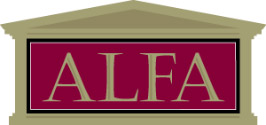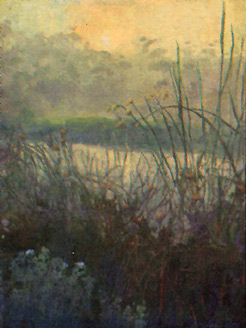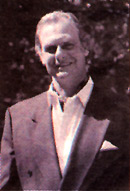Peter Adams: Carrying on a Golden Tradition
ART-TALK
August / September, 1997
PETER ADAMS: CARRYING ON A GOLDEN TRADITION
by Danny Medina
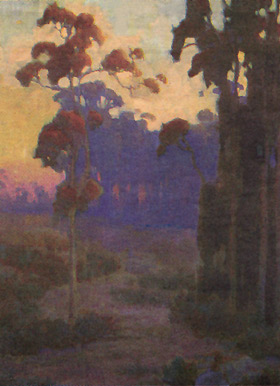 Eucalyptus at Twilight,Oil on Board, 24″ x 18″
Eucalyptus at Twilight,Oil on Board, 24″ x 18″
“Peter Adams holding to the century-old outdoor tradition of California painters.”
PASADENA – The Pasadena morning could not have been more beautiful if it had been commissioned. The bright, intense California sun casts dappled sunlight on the elegant row of mansions set far back into their wooded lots, bringing back memories of the Great Gatsby era when life was lived on a grand scale. Artist Peter Adams meets me at the door, and he look just like one of the characters from F. Scott Fitzgerald’s book. Chic beyond words, the silk paisley ascot tie, the impeccably pressed, starched, monogrammed shirt and the slacks with the knife edged crease all look perfect. The grounds of the home equate to the standards of a person of high breeding simple, elegant and reeking with good taste. The immaculately manicured expanses of lush baby tear lawns wrap themselves around ferns and fuchsia, and the heady perfume of the magnolia blossoms seem to be everywhere.
Brunch is being served al fresco in the back yard where the hillside is alive with birds and a waterfall that cascades down hundreds of feet. The sunlight dances off the silver coffee pot, playing hide-and-seek through the overhead vines as Elaine Adams, Peter’s lovely wife, refills my fine porcelain cup. The conversation continues about the California Art Club.
Peter’s intense blue eyes dance as he regales me with information about the club. It doesn’t take a Rembrandt mentality to see Peter’s love and commitment to this arts organization that he and Elaine have brought to the forefront of the art world from a nearly sure death.
The club’s membership once boasted some of the great names in the California art scene. These artists have not only become household names in the traditional art world, but bring staggering prices at sales and auctions.
As all clubs do (like the National Academy), they tend to ran their course and either die on the vine or or, to keep membership up, begin admitting members who either don’t belong or are not worthy. This is precisely what happened to the California Art Club.
Fading Sun , Oil on Board, 40″ x 30″
“An indication of the variety
California has to offer artists.”
It was started in 1909 by several well known names even back then: Frank Tenney Johnson, Carl Oscar Borg, Hanson Puthuff, William Wendt and first president Frank R. Liddell who was a full-time banker and part-time artist. Wendt was the mentor who went on to become the second president and then president emeritus for more than 20 years.
In 1976 Peter joined the organization, but it was not a long membership because by the time he joined it had become pretty well watered down. The membership was mostly hobbyists and dealers. “It was just like all the other art clubs around,” says Peter. “You know, there are thousands. of them. It kind of deteriorated to that level.”
Most of the membership,, says Peter, was either dead or verging on death when he became aware of the club. The California Art Club once enjoyed the reputation of being very difficult to get into. In the 1920s, for example, there were only 35-45 members, so it wasn’t a big group, but they were all good painters. Says Peter, “Basically, all the good California plein air painters were in the club.”
After Peter dropped his membership because of the watered down status, he says he thought the club had sort of died off. One day while he was chatting with Jeff Morseburg they both agreed that one of the things that the California art community lacked was something like the old California Art Club to promote traditional art. “We both said, ‘Yeah, pity it doesn’t exist anymore and isn’t it a shame! The very next day someone came in and said they belonged to the California Art Club and were looking for members and so forth and did Jeff know any? A few days later the lady called Peter and asked him how he would like to be a member. Peter said to her, “I was a member few years ago, but sure, I’ll join.” The lady responded by saying, “That will be $15, and now that you’re a member, how would you like to be president of the club?”
Peter remembers, “I thought long and hard about it. I told myself that if I could get some of my artistic friends that I really respected, professional artists, and really make it into a much more professional venue, we might have a real go at it. So I got together about seven or eight of my friends who to said they would support it and join the club, and that’s how we got started with the California Art Club in 1993.”
The question arise’s here as to why an artist of Peter Adams’ stature who is successful in his art career would care whether the club existed at all. After all, it is no big secret that spearheading any kind of club takes an inordinate amount of time and effort. When asked why, Peter smiles and says, “Basically, what I wanted to do was this. I am a fairly successful artist here in the Los Angeles area, and when I would have shows I found that all my other friends were off showing in Scottsdale and Santa Fe. I thought, gosh, we have so many good artists here, and I would like to keep them in this area. Why don’t we develop a traditional art movement in the Southern California area? So you see, Danny, that is why I got so involved with the California Art Club, because we wanted to promote traditional art. It’s not that we care a lot about the club. We care a lot more about the art. We are not against modern art at all, but we feel traditional art just doesn’t get. the attention it should.”
Elaine Adams is also deeply devoted to the club. She says, “We are finding that galleries that once only handled dead artists are now handling our artists and helping the club. Which is exciting,” adds Peter. “I think we have a really strong historical base as well. That is the thing that the California Art Club has, is a great history and a great past. We have a monthly meeting, and at most of our meetings we have great art historians such as jean Stem, who is the director of the Joan Irvine Museum.”
The reawakening of the club has helped what Peter calls “the brain drain.” Elaine says that they discovered upon taking over the club that many artists were isolated, almost hermits, knowing very few fellow artists. “We just didn’t realize how many what we refer to as contemporary traditional artists there are. We only saw the ones i Santa Fe, Scottsdale and Colorado. We realized that the few artists who were living in California were moving there.” Both Peter and Elaine made a commitment right there to stop this brain drain and keep them in their midst by reviving the, club and by holding the annual Gold Medal show, which is just for California resident artists. “We do take artists from other states as members, but for the Gold medal show they have to reside here. It was our way of keeping artists here,” says Elaine.
Peters says that the art galleries they work with are very supportive, galleries like Joan Irvine Smith’s, putting, little stamps on their advertising saying they are members of the California Art Club. Peter says, “Everyone in her gallery is a member. Not only that, but she gives us all kinds of prize money and sets up some competitions for us. Jeff Morseburg has also been very, very supportive, and when he gets a good artist, he wants to get them into the club right away. he also writes articles for us and just did an exhibit of plein air paintings for us, so you see they really do support the club. What is interesting is the collectors. You hear them asking the dealers, ‘Is this a California Art Club artist?’ What we are feeling is that they feel confident in purchasing these artists because they see them getting public recognition, and they feel more comfortable investing in these artists where before they hadn’t heard of them. In many cases, they like the work but aren’t sure that the artist is going to continue. It shows this artist is serious. We find that the support of the group is really supplying confidence to the collectors.
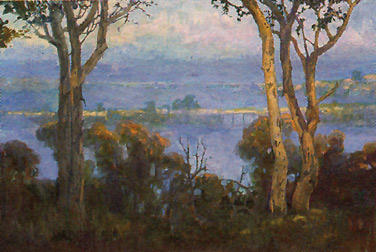 Rising Fog , Oil on Board, 24″ x 36″
Rising Fog , Oil on Board, 24″ x 36″
“Adams captures the soft light that only seems t shine just this way in the Golden State.”
“We also see that a number of the other galleries get involved. We send George Stern 50 newsletters every, month, as well as Whitney Ganz (William) Karges Gallery. George Stem handles a few contemporary artists but he’s mostly traditional. But a lot of galleries are excited about our newsletter. It is interesting because when we do our Gold Medal show we have galleries coming from San Francisco or as far as Lake Tahoe or other places to pick up artists to show in their galleries.”
The Gold Medal show is a for-sale show, however both Peter and Elaine explain to me that they really are reticent to push sales because, as is usually the case with these shows, they tend to undercut the galleries, and they don’t like that.
Competition between art associations or clubs is well known, and of course there are many throughout the country. But Peter says the California Art Club of the isn’t in competition with anyone. Peter is also a member of Plein Air Painters of America, and he says he has to give Denise Burns a lot of credit for doing such a good job, because he himself knows it is a lot of work. “She has helped to bring out plein air painters Hers was the first. group to do that and you have to give her credit for that.” Sadly, Peters adds, “There are many good artists that were in the group who have left, unfortunately. There were some personality problems there, but I would say to them when the subject came up, ‘Just stick in there for another year or two.’ Now Kevin Macpherson is the president, and it’s great, I love them. You have to understand, we are a different type of group. They have only 30 people, while we have a thousand people. They can do things we can’t, and we can do things they can’t do. So you see there is no competition between us.”
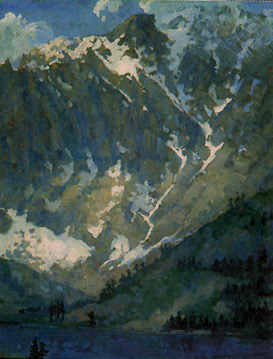 Afternoon in the Sierras,Oil on Board, 40″ x 30″
Afternoon in the Sierras,Oil on Board, 40″ x 30″
“Grandeur of the western mountain
range rising to the sun .”
To prove his point, Peter tells me that recently the Carmel Art Alliance called and asked if the California Art Club would like to come up and paint. Peter says, “I said sure we’ll do that! But why don’t we ask the Plein Air Painters to come up as well. We like all the arts organizations, such as the Oil Painters of America. In fact, we gave Shirl Smithson the Woman of the Year Award last year, and we gave Susan McGarry the Woman of the Year Award this year. We think it’s great having all those different organizations all over the country. We love those kinds of grass roots things. That’s one reason we did this last show with the American Society of Classical Realism out of Minneapolis. I I find this terribly exciting.”
Things are looking very good for the California Art Club. They have recently been given a tax-free status with the official name of the California Art Academy and Museum which they just started. “As of April 29 we’re incorporated and non-profit,” says Peter. “We’re starting a school and museum together with a library. Of course, we still don’t have a building. We do have a few people on the board and we are starting to raise money for it. We would very much, like to. have it somewhere in the Pasadena area,” boasts Peter.
In order to understand why Peter would take on this enormous task you have to know a little about him. First, he is a successful professional, working artist. More importantly, he is a fourth-generation Californian whose roots are deeply imbedded in the history of old Pasadena. These old families, like old eastern families, teach their children early in their lives that it is their God-given duty to give back to their communities in time and money. Peter is obviously not one to shirk his duties. With the help of lovely wife Elaine, they have brought back the California Art Club to its one-time giory days. In fact, they have already surpassed those earlier times. The California Art Club has become one of the most important art organizations in the nation.
One day in the not-too-distant future I predict that the initials C.A.C. behind an artist’s name will mean a lot more than, say, N.A.
